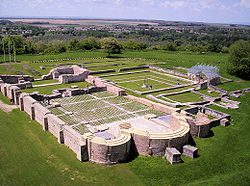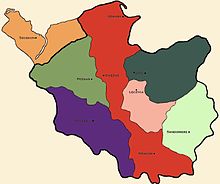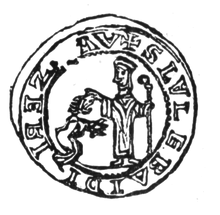Bolesław III Wrymouth
Bolesław sought to gain Pomerania which caused an armed conflict between the brothers, and forced Zbigniew to flee the country and seek military help from King Henry V of Germany.After her death, Bolesław married a German noblewoman, Salomea of Berg, which in some way was the cause of changes in Polish foreign policy: in the second half of his rule, the duke sought to restore diplomatic relations with his western neighbor.[13] The lack of a legitimate heir, however, remained a concern for Władysław I and in 1085 he and his wife Judith of Bohemia sent rich gifts, among which was a life size statue of a child made of gold, to the Benedictine Sanctuary of Saint Giles[14] in Saint-Gilles, Provence begging for offspring.However, Jasiński pointed the weaknesses of the argument of Szafrański because Gallus has written about the Octave, but specifically about Christmas night, but the investigator didn't consider all other sources, as well as the achievements of research in genealogy.[36] Bolesław's nickname "Wrymouth" (pl: Krzywousty) appeared in Polish and Latin sources of the 13th century: Genealogia płocka (Criwousti)[37] and the Rocznik świętokrzyski młodszy (Crzyvousti).[36][39] The 15th-century chronicler Jan Długosz wrote: In March 1972, in the Masovian Blessed Virgin Mary Cathedral of Płock, where according to tradition Bolesław was buried, an archaeological research project was conducted.The chosen bride was Judith-Maria, daughter of Emperor Henry III and widow of King Solomon of Hungary, who after her wedding took the name Sophia in order to distinguish herself from Władysław I Herman's first wife.[60][61] In the absence of Sieciech and Bolesław, who were captured by Hungarians, duke Władysław I then undertook a penal expedition to Silesia, which was unsuccessful and subsequently obliged him to recognize Zbigniew as a legitimate heir.In view of his father's disapproval, and after discovering the plans of Sieciech and Duchess Judith-Sophia to take over the country Zbigniew gained an ally in the young duke Bolesław.[72] In response to Sieciech's preparations Bolesław and Zbigniew entered into an alliance at a popular assembly or Wiec organized in Wrocław by a magnate named Skarbimir of the Awdaniec family.[86] Bolesław retaliated with expeditions into Pomerania in 1103 (including the battle of Kołobrzeg, where he was defeated[87]) and Moravia in 1104–05, which brought the young duke not only loot, but also effectively ended the Pomeranian alliance.[95] The allied forces of Bolesław easily took control of most important cities, including Kalisz, Gniezno, Spycimierz and Łęczyca,[96] in effect taking half of Zbigniew's lands.[98] In 1107 Bolesław III along with his ally King Coloman of Hungary invaded Bohemia in order to aid Svatopluk in gaining the Czech throne and to secure Polish interests to the south.[104] In response to Bolesław's aggressive foreign policy, the Holy Roman Emperor, Henry V, undertook a punitive expedition against Poland in 1109,[106] assisted by Czech warriors provided by Svatopluk of Bohemia.[108] The military operations mainly took place in Silesia in southwestern Poland, where Henry V's army laid siege to the major cities of Głogów, Wrocław and Bytom Odrzański.[114] Bolesław's assent was likely under pressure from the many supporters of the exiled duke in 1108, who, according to the reports of Gallus Anonymus, was surrounded by bad advisers (probably including Martin I, Archbishop of Gniezno[115]).[125] Following his return to Poland, Bolesław even traveled to Gniezno to pay further penance at the tomb of Saint Adalbert of Prague, where poor people and clergy received numerous costly gifts from the duke .[129] The loss of Pomerania during the reign of Casimir I the Restorer weakened the Polish state, and, during the second half of the 11th century, subsequent rulers were not able to recover all the lands that once belonged to Mieszko I and Bolesław I the Brave.[132] Before Bolesław III began to expand in Gdańsk Pomerania (Pomerelia), he normalized his political relations with Bohemia in 1114 at a great convention on the border of the Nysa Kłodzka river.[135] The conquest of this part of the Pomeranian lands from 1115 to 1119 achieved a long-time aim of previous Polish rulers: the complete incorporation of the territories on the Vistula River, including the castellany of Nakło, into Poland.[139] Other probable factors were the desire to establish Władysław II, Bolesław's first-born son, as the sole ruler after his death, or Boleslaw's fears of losing his position, as had happened in the conflict with Sieciech.Duke Wartislaw I was forced to pay homage, as well as an annual tribute of 500 marks of fine silver to the Polish ruler,[158] and was further obliged to give military aid at Bolesław's request.The fleet transported Polish troops to Rügen, but the intended battle on the island never happened, because, at the sight of the Polish-Danish combined forces, the defending Rani recognized Bolesław's overlordship.[182] After the successful invasion of the Danish capital, Roskilde, in 1134, Bolesław formed an alliance with Wartislaw I of Pomerania against King Eric II of Denmark, an ally of Emperor Lothair III.On 7 July 1136, Pope Innocent II issued the protectionist Bull[190] Ex commisso nobis a Deo[191] under which the unquestioned sovereignty of the Archbishopric of Gniezno over the Polish dioceses was confirmed.Wawrzyniec Wszerecz, Canon of Płock during the 16th–17th centuries, wrote that Bolesław was in a common coffin at the cathedral, where the remains of his father Władysław I Herman and several other Piast Masovian rulers were also placed.Distribution of the then-princely rights by contemporary historiography also had benefits, which include: the reconstruction of the political system in the new economic fundamentals and placement of greater responsibility for the fate of the country upon its upper echelons.[277] Bolesław's personal guard was probably chosen by himself, using an invocation which was written in the Chronicles of Gallus Anonymous: The nobles maintained their own army, which consisted of poor knights supported by peasants.[276] In addition to the nobles (who were tied to the ruler and his court) and warriors the Polish society in Bolesław's times also consisted of free peasants and servants (attached to his place of residence).[285] Up to them to submit certain levies, tithes, and other forms of taxes like the podworowe (in the form of a cow, which consisted of the entire village), podymne (for every house), poradlne (for each piece of land), narzazu (for grazing pigs in the woods), the stacji or stanu (who allow the maintenance of the duke's court) and the posług komunikacyjnych, who regulated the transport ways in the country and was divided in three main taxes: przewód ("the cable"), powóz ("the carriage") and podwód ("the wagon").






The
Seniorate Province
(Eastern
Greater Poland
, Western
Kuyavia
,
Wieluń Land
,
Lesser Poland
) under Władysław II the Exile
Silesian Province of
Władysław II the Exile
Sandomierz Province of
Henry of Sandomierz
, split off from the Seniorate Province
Pomerania, fiefdom of Poland under the control of the princely superior of Poland (princeps)





Duke of PolandWładysław I HermanWładysław II the ExilePłockPolandSochaczewMasovian Blessed Virgin Mary CathedralZbyslava of KievSalomea of BergRichezaBolesław IV the CurlyMieszko III the OldDobroniega LudgardaJudithCasimir II the JustJudith of BohemiaRoman CatholicPolishLesser PolandSilesiaSandomierzCount palatineSieciechZbigniewPomeraniaHenry V of GermanySaint GilesHungaryBolesław II the GenerousKievan RusNotećWestern PomeraniaGdańsk Pomeraniaconverting PomeraniaOtto of BambergZbyslavatestament known as "The Succession Statute"archbishopric of GnieznoVratislav IIBohemiaLászló IBolesław II the BoldMieszko BolesławowicKrakówBenedictineSaint-GillesProvenceGallus AnonymusSaint Stephen, King of HungaryCosmas of PragueCalendsSaint StephenOswald BalzerJulian calendarMarian PleziaJan DługoszpanegyricQuedlinburgSaxonyJudith-MariaHenry IIISolomon of HungaryWda Riverbattle of GopłoFirst CrusadeMazoviaWrocławGreater PolandGnieznoKuyaviaŁęczycaSieradzLubusz LandSkarbimirŻarnowiecPilicaŽatecMiecznikBretislaus II, Duke of BohemiaSieciechówMasoviaAwdaniec familyPrussiaBiałogardPomeraniansBořivoj IISviatopolk IIPaschal IIHoly Roman EmpireKołobrzegPomeranianÁlmosAbaújvárColomanPragueSvatoplukTyniecKaliszSpycimierzBishop of KrakówKurówPuławyPozsony CastleRacibórzKoźleHoly Roman EmperorHenry VGłogówBattle of HundsfeldMarcin BielskiBytom OdrzańskiSoběslav IMartin I, Archbishop of GnieznoAdventexcommunicatedSomogyvárSaint Stephen ISzékesfehérvárArpad dynastySaint Adalbert of PragueLubińPomerania during the High Middle AgesDuchy of PomeraniaConversion of PomeraniaCasimir I the RestorerMieszko I